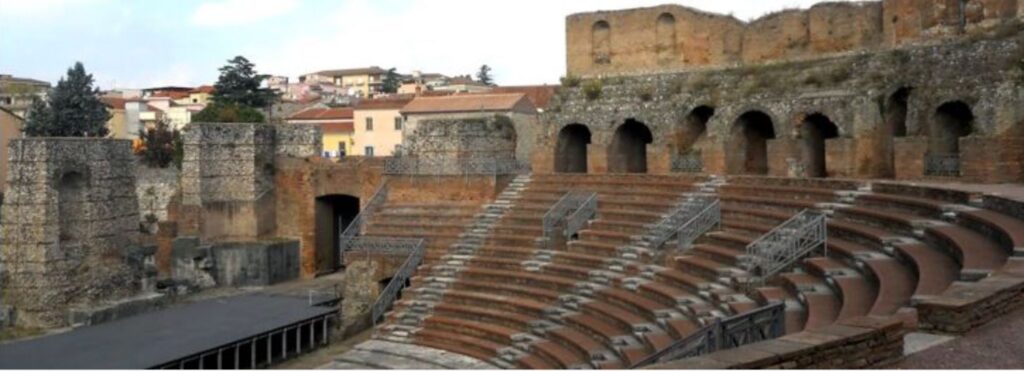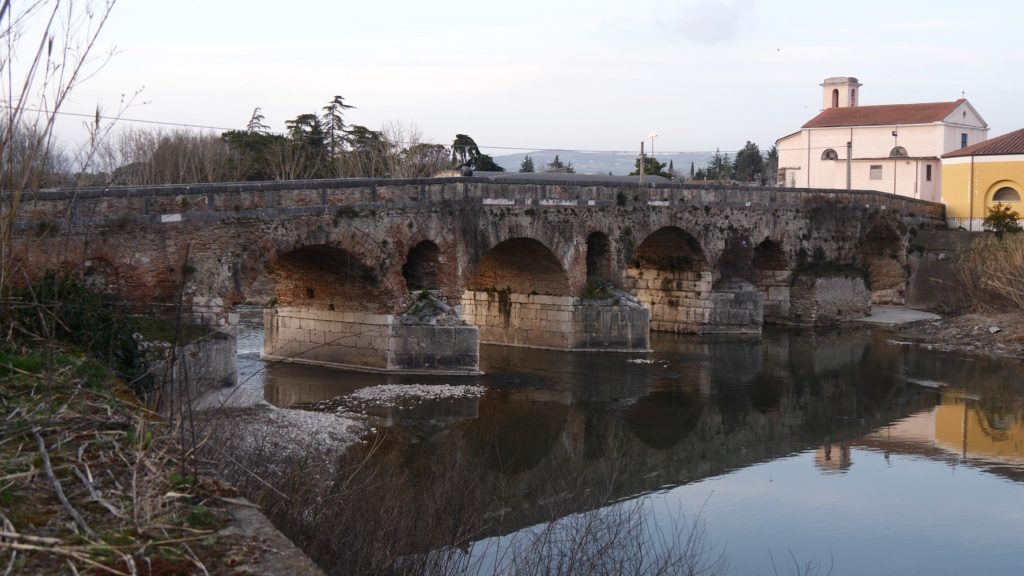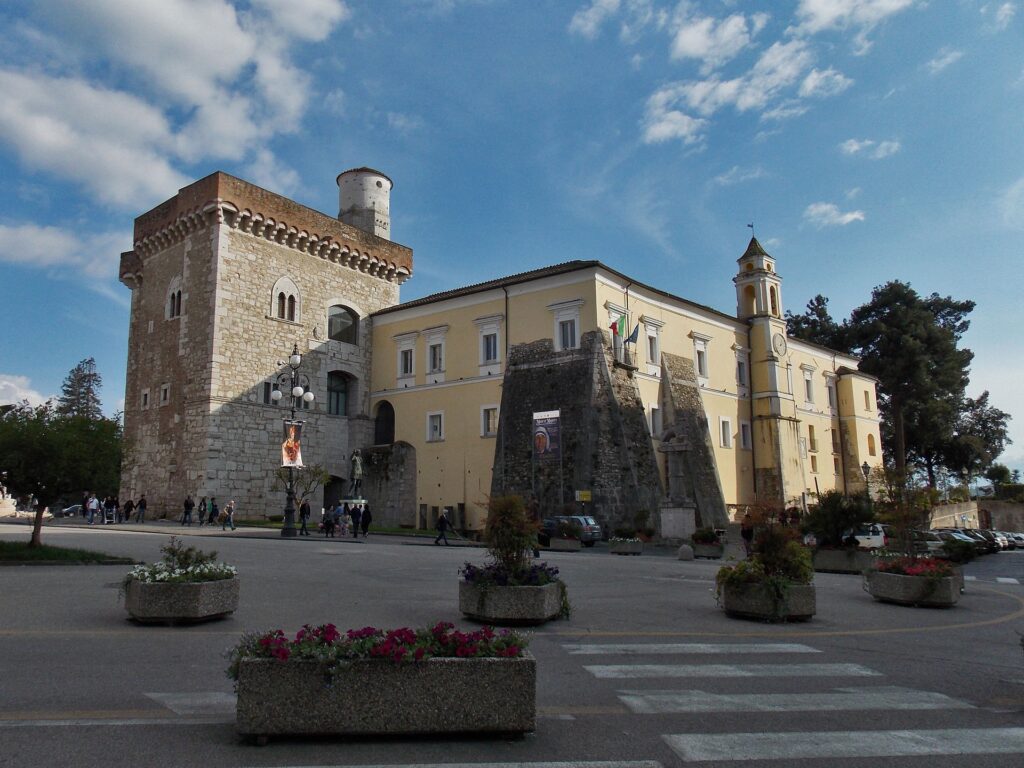The city of Benevento is located in the southern part of the Apennine hinterland of Campania, in the Samnium region, halfway between the Tyrrhenian and the Adriatic Sea: an important stop on the Appian Way. Under emperor Trajan it became the starting point of the Appia Traiana, an alternative way along the Adriatic coast towards Brindisi.
History of the city in the Roman period
Originally called Maleventum by the Samnites, was later renamed by the Romans in Beneventum probably in memory of the victory reported, near the city, on Pyrrhus in 275 bc.C., but also because the first name was considered a bad luck. Other important battles were fought here during the Second Punic War. Great strategic and commercial importance acquired the city thanks to the passage of the Appia. In 86 .C the Romans raised Beenventum to the rank of municipium and in 7 .C. Augustus annexed it to the royal II Apulia et Calabria but later, under Hadrian,it was attributed to Campania. Emperor Trajan chose it as the starting point for the new route that took its name, the Appia Traiana, which brought the route to Brindisi on the Adriatic coast. Thus the city prospered even more, enriched itself with many monuments and became the second most populous city in Campania, after Capua. The most significant monuments of the Roman period are: the Trajan’s Arch, the Roman Theater, the Arch called the Sacrament, the Leproso Bridge, the Valentino Bridge. Also worth mentioning is the Samnium Museum, which contains, among other things, the finds that probably belonged to the temple of Isis but found in various places in Benevento, since the location of the temple has never been discovered.
Arch of Trajan
Not only is it the main monument of Benevento but it is also the best preserved honorary Roman arch. It’s pretty much intact. It was erected at the starting point of the Appia Traiana between 114 and 117 .C. The Arch of Trajan is 15.60 meters high, consists of a single arch 8 meters high, is covered with marble and is decorated with scenes in bas-relief of war and peace. The vault of the arch is decorated with coffered.
Roman theatre
The Roman theatre was probably erected by Trajan near the “cardo maximus”, but was inaugurated in 126 under emperor Hadrian, and enlarged by Caracalla between 200 and 210. It measures 90 meters in diameter and could hold about 10,000 spectators. It was covered with polychrome marble, and its atria were decorated with stuccoes and mosaics. The theater was abandoned in the Lombard era, used as a foundation for some houses, partially buried later, above one end of the hemicycle, was built the church of Santa Maria della Verità. The recovery work begun at the end of the nineteenth century but was not completed until 1957; since then the theater is back in operation. Today you can see the semicircular cavea, part of the front, the first and part of the second of the three orders of arches, while the marble cladding has largely dispersed.
The Arch of the Sacrament
The construction of the arch can be dated between the end of the first and the beginning of the second century and surmounts Via Carlo Torre, on the corner of the Archbishop’s Palace. The façade of the Arch of the Sacrament is now devoid of the marble cladding, of which some parts remain, and of the statues originally housed in the niches on the sides of the fronts. The arch was the entrance of the Forum from south, near the Roman theater. The restoration of the arch and its surrounding facilities has brought to light a thermal complex.
Leproso Bridge
To cross the Sabato river, on the Via Appia just before Benevento, in the 3rd century BC a.C a bridge was built with the typical donkey back structure. It was restored by both Septymius Severus and his son Caracalla. At its end stood a cryptoporticu, then transformed into the church of the forty martyrs of Sebaste. It was destroyed by the Goths of the 6th century and then rebuilt. After the earthquake of 1702 it was renovated with the reduction of the number of arches from five to four. Of the Roman structure remains one of the pylons, built in square work. Originally it was called Marmoreo and in the Middle Ages it was renamed Leproso probably because of the proximity of a leper rosary.
Valentino Bridge
The Valentino bridge was built in the 2nd century by emperor Flavius Valens on the Calore Irpino river about 2 kilometers east of Benevento. The donkey back structure consists of three arches. The name probably comes from a nearby church dedicated to Valentine’s Day.
Samnium Museum
The Museo del Sannio is the main museum of Benevento, set up in the Rocca dei Rettori. Here you will find important finds from the Samnitical, Roman and Lombard era, and a series of works of art from the 16th to the 20th centuries. Inside the Museum there are many Egyptian finds, concerning above all the cult of the goddess Isis who in Benevento was very much felt during the imperial age. Inscriptions report the presence in Benevento of a grandiose temple dedicated to Isis.
In Benevento there are also many other monuments of particular cultural interest. Many churches include: the Church of Santa Sofia of the Lombard era and its monumental complex, the Cathedral of Sancta Maria de Episcopio with the Pisan Romanesque façade, the church of Sant’Ilario in Port’Aurea, the church of the Most Holy Saviour, the monastery of San Vittorino, the basilica of San Bartolomeo Apostolo. There are also many stately palaces and villas, fountains and monuments, obelisks, the remains of the Roman aqueduct and the river port, the Lombard walls. Finally, the Rocca dei Rettori, the castle of Benevento, located on the highest point of the city, consisting of two distinct buildings: the Torrione, built by the Lombards from 871, and the Palazzo dei Governatori, built by the popes from 1320. In the garden it preserves the remains of a Roman-era spa building.







